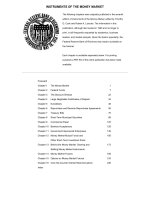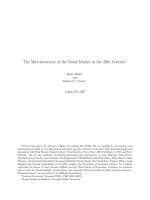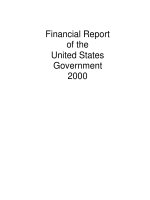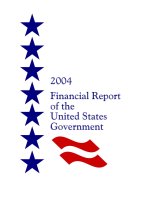Financial modeling of the equity market from CAPM to cointegration FRANK j FABOZZI SERGIO m FOCARDI PETTER n KOLM
Bạn đang xem bản rút gọn của tài liệu. Xem và tải ngay bản đầy đủ của tài liệu tại đây (9.05 MB, 673 trang )
ffirst.frm Page iii Tuesday, December 13, 2005 9:08 PM
Financial Modeling
of the Equity
Market
From CAPM to Cointegration
FRANK J. FABOZZI
SERGIO M. FOCARDI
PETTER N. KOLM
John Wiley & Sons, Inc.
ffirst.frm Page vi Tuesday, December 13, 2005 9:08 PM
ffirst.frm Page i Tuesday, December 13, 2005 9:08 PM
Financial Modeling
of the Equity
Market
ffirst.frm Page ii Tuesday, December 13, 2005 9:08 PM
THE FRANK J. FABOZZI SERIES
Fixed Income Securities, Second Edition by Frank J. Fabozzi
Focus on Value: A Corporate and Investor Guide to Wealth Creation by James L. Grant and
James A. Abate
Handbook of Global Fixed Income Calculations by Dragomir Krgin
Managing a Corporate Bond Portfolio by Leland E. Crabbe and Frank J. Fabozzi
Real Options and Option-Embedded Securities by William T. Moore
Capital Budgeting: Theory and Practice by Pamela P. Peterson and Frank J. Fabozzi
The Exchange-Traded Funds Manual by Gary L. Gastineau
Professional Perspectives on Fixed Income Portfolio Management, Volume 3 edited by Frank
J. Fabozzi
Investing in Emerging Fixed Income Markets edited by Frank J. Fabozzi and Efstathia Pilarinu
Handbook of Alternative Assets by Mark J. P. Anson
The Exchange-Traded Funds Manual by Gary L. Gastineau
The Global Money Markets by Frank J. Fabozzi, Steven V. Mann, and
Moorad Choudhry
The Handbook of Financial Instruments edited by Frank J. Fabozzi
Collateralized Debt Obligations: Structures and Analysis by Laurie S. Goodman and Frank J.
Fabozzi
Interest Rate, Term Structure, and Valuation Modeling edited by Frank J. Fabozzi
Investment Performance Measurement by Bruce J. Feibel
The Handbook of Equity Style Management edited by T. Daniel Coggin and
Frank J. Fabozzi
The Theory and Practice of Investment Management edited by Frank J. Fabozzi and Harry M.
Markowitz
Foundations of Economic Value Added: Second Edition by James L. Grant
Financial Management and Analysis: Second Edition by Frank J. Fabozzi and
Pamela P. Peterson
Measuring and Controlling Interest Rate and Credit Risk: Second Edition by
Frank J. Fabozzi, Steven V. Mann, and Moorad Choudhry
Professional Perspectives on Fixed Income Portfolio Management, Volume 4 edited by Frank
J. Fabozzi
The Handbook of European Fixed Income Securities edited by Frank J. Fabozzi and Moorad
Choudhry
The Handbook of European Structured Financial Products edited by Frank J. Fabozzi and
Moorad Choudhry
The Mathematics of Financial Modeling and Investment Management by Sergio M. Focardi
and Frank J. Fabozzi
Short Selling: Strategies, Risks, and Rewards edited by Frank J. Fabozzi
The Real Estate Investment Handbook by G. Timothy Haight and Daniel Singer
Market Neutral Strategies edited by Bruce I. Jacobs and Kenneth N. Levy
Securities Finance: Securities Lending and Repurchase Agreements edited by
Frank J. Fabozzi and Steven V. Mann
Fat-Tailed and Skewed Asset Return Distributions by Svetlozar T. Rachev, Christian Menn,
and Frank J. Fabozzi
Financial Modeling of the Equity Market: From CAPM to Cointegration by Frank J. Fabozzi,
Sergio M. Focardi, and Petter N. Kolm
Advanced Bond Portfolio Management: Best Practices in Modeling and Strategies edited by
Frank J. Fabozzi, Lionel Martellini, and Philippe Priaulet
ffirst.frm Page iii Tuesday, December 13, 2005 9:08 PM
Financial Modeling
of the Equity
Market
From CAPM to Cointegration
FRANK J. FABOZZI
SERGIO M. FOCARDI
PETTER N. KOLM
John Wiley & Sons, Inc.
ffirst.frm Page iv Tuesday, December 13, 2005 9:08 PM
Copyright © 2006 by John Wiley & Sons, Inc. All rights reserved
Published by John Wiley & Sons, Inc., Hoboken, New Jersey
Published simultaneously in Canada
No part of this publication may be reproduced, stored in a retrieval system, or transmitted in
any form or by any means, electronic, mechanical, photocopying, recording, scanning, or otherwise, except as permitted under Section 107 or 108 of the 1976 United States Copyright
Act, without either the prior written permission of the Publisher, or authorization through
payment of the appropriate per-copy fee to the Copyright Clearance Center, Inc., 222 Rosewood Drive, Danvers, MA 01923, (978) 750-8400, fax (978) 750-4470, or on the web at
www.copyright.com. Requests to the Publisher for permission should be addressed to the Permissions Department, John Wiley & Sons, Inc., 111 River Street, Hoboken, NJ 07030, (201)
748-6011, fax (201) 748-6008, or online at />Limit of Liability/Disclaimer of Warranty: While the publisher and author have used their best
efforts in preparing this book, they make no representations or warranties with respect to the
accuracy or completeness of the contents of this book and specifically disclaim any implied
warranties of merchantability or fitness for a particular purpose. No warranty may be created
or extended by sales representatives or written sales materials. The advice and strategies contained herein may not be suitable for your situation. You should consult with a professional
where appropriate. Neither the publisher nor author shall be liable for any loss of profit or
any other commercial damages, including but not limited to special, incidental, consequential,
or other damages.
For general information on our other products and services or for technical support, please
contact our Customer Care Department within the United States at (800) 762-2974, outside
the United States at (317) 572-3993 or fax (317) 572-4002.
Wiley also publishes its books in a variety of electronic formats. Some content that appears in
print may not be available in electronic books. For more information about Wiley products,
visit our web site at www.wiley.com.
ISBN-13 978-0471-69900-2
ISBN-10 0-471-69900-4
Printed in the United States of America
10 9 8 7 6 5 4 3 2 1
ffirst.frm Page v Tuesday, December 13, 2005 9:08 PM
FJF
To my wife Donna and my children,
Francesco, Patricia, and Karly
SMF
To the memory of Bertrand Russell to whom I owe
the foundation of my intellectual development
PNK
To my best friend, my wife, and my love—Carmen
ffirst.frm Page vi Tuesday, December 13, 2005 9:08 PM
ftoc.frm Page vii Tuesday, December 13, 2005 9:06 PM
Contents
Preface
Acknowledgments
About the Authors
CHAPTER 1
Introduction
Historical Perspective on the Financial Modeling of the Equity Market
Central Themes of the Book
Organization of the Book
xiii
xvii
xix
1
1
8
9
PART ONE
Portfolio Allocation: Classical Theory and Modern Extensions
13
CHAPTER 2
Mean-Variance Analysis and Modern Portfolio Theory
The Benefits of Diversification
Mean-Variance Analysis: Overview
Classical Framework for Mean-Variance Optimization
The Capital Market Line
Selection of the Optimal Portfolio When there Is a Risk-Free Asset
More on Utility Functions: A General Framework for Portfolio Choice
Summary
15
17
19
22
34
40
42
48
CHAPTER 3
Transaction and Trading Costs
A Taxonomy of Transaction Costs
Liquidity and Transaction Costs
Market Impact Measurements and Empirical Findings
Forecasting and Modeling Market Impact
Incorporating Transaction Costs in Asset-Allocation Models
Optimal Trading
51
52
60
63
68
74
80
vii
ftoc.frm Page viii Tuesday, December 13, 2005 9:06 PM
viii
Contents
Integrated Portfolio Management:
Beyond Expected Return and Portfolio Risk
Summary
CHAPTER 4
Applying the Portfolio Selection Framework in Practice
Rebalancing in the Mean-Variance Optimization Framework
Portfolio Constraints Commonly Used in Practice
Summary
CHAPTER 5
Incorporating Higher Moments and Extreme Risk Measures
Dispersion and Downside Measures
Portfolio Selection with Higher Moments through Expansions of Utility
Polynomial Goal Programming for Portfolio
Optimization with Higher Moments
Some Remarks on the Estimation of Higher Moments
The Approach of Malevergne and Sornette
Summary
CHAPTER 6
Mathematical and Numerical Optimization
Mathematical Programming
Necessary Conditions for Optimality for
Continuous Optimization Problems
How Do Optimization Algorithms Work?
Optimization Software
Practical Considerations when Using Optimization Software
Summary
82
85
87
88
100
113
115
116
131
139
141
142
147
149
150
158
159
176
180
187
PART TWO
Managing Uncertainty in Practice
CHAPTER 7
Equity Price Models
Definitions
Theoretical and Econometric Models
Random Walk Models
General Equilibrium Theories
Capital Asset Pricing Model (CAPM)
Arbitrage Pricing Theory (APT)
Summary
189
191
191
193
194
207
208
212
213
ftoc.frm Page ix Tuesday, December 13, 2005 9:06 PM
Contents
CHAPTER 8
Forecasting Expected Return and Risk
Dividend Discount and Residual Income Valuation Models
The Sample Mean and Covariance Estimator
Random Matrices
Arbitrage Pricing Theory and Factor Models
Factor Models in Practice
Factor Models in Practice: An Example
Other Approaches to Volatility Estimation
Application to Investment Strategies and Proprietary Trading
Summary
CHAPTER 9
Robust Frameworks for Estimation and Portfolio Allocation
Robust Frameworks for Estimation and Portfolio Allocation
Practical Problems Encountered in Mean-Variance Optimization
Shrinkage Estimation
Bayesian Approaches
Incorporating Estimation Error and Uncertainty in the
Portfolio Allocation Process
Summary
ix
215
217
222
231
234
241
245
259
264
265
267
267
269
275
281
304
318
PART THREE
Dynamic Models for Equity Prices
321
CHAPTER 10
Feedback and Predictors in Stock Markets
Random Walk Models and Their Shortcomings
Time Diversification
A Multiagent Economy: Effects of Agent Heterogeneity and Interactions
Market Predictors
Time Aggregation
Summary
323
323
333
339
343
345
345
CHAPTER 11
Individual Price Processes: Univariate Models
Time Series Concepts
Digression on White Noise and Martingale Difference Sequences
The Lag Operator L
Univariate Autoregressive Moving Average (ARMA) Models
Stationarity Conditions
Auto Correlations at Different Lags
Solutions of an AR(p) Process
347
348
350
353
353
354
357
358
ftoc.frm Page x Tuesday, December 13, 2005 9:06 PM
x
Contents
MA(q) Moving Average Models
ARMA(p,q) Models
Integrated Processes
Summary
362
363
364
365
CHAPTER 12
Multivariate Models
Dynamic Models: A Historical Perspective
Vector Autoregressive Models
Vector Autoregressive Moving Average Models (VARMA)
Distributional Properties
Cointegration
Stochastic and Deterministic Cointegration
Common Trends
Error Correction Models
Forecasting with VAR Models
State-Space Models
Autoregressive Distributed Lag Models
Dynamic Factor Models
The ARCH/GARCH Family of Models
Nonlinear Markov-Switching Models
Summary
367
368
370
385
386
386
392
393
395
396
397
399
402
402
404
405
CHAPTER 13
Model Selection and its Pitfalls
Model Selection and Estimation
The (Machine) Learning Approach to Model Selection
Sample Size and Model Complexity
Dangerous Patterns of Behavior
Data Snooping
Survivorship Biases and Other Sample Defects
Moving Training Windows
Model Risk
Model Selection in a Nutshell
Summary
407
407
410
415
419
424
426
428
430
431
433
PART FOUR
Model Estimation amd Model Risk Mitigation
CHAPTER 14
Estimation of Regression Models
Probability Theory and Statistics
Populations of Prices and Returns
437
439
439
442
ftoc.frm Page xi Tuesday, December 13, 2005 9:06 PM
Contents
Estimation at Work
Estimators
Sampling Distributions
Critical Values and Confidence Intervals
Maximum Likelihood, OLS, and Regressions
The Fisher Information Matrix and the Cramer-Rao Bound
Regressions
Linear Regressions
Sampling Distributions of Regressions
Relaxing the Normality and Uncorrelated Noise Assumptions
Pitfalls of Regressions
The Method of Moments and its Generalizations
Summary
xi
444
445
446
450
450
453
454
456
464
468
469
471
475
CHAPTER 15
Estimation of Linear Dynamic Models
An Approach to Estimation
Unit Root Testing
Estimation of Linear Regression Models
Estimation of Stable Vector Autoregressive (VAR) Models
Estimating the Number of Lags
Autocorrelation and Distributional Properties of Residuals
Stationary Autoregressive Distributed Lag Models
Applying Stable VAR Processes to Financial Econometrics
Stationary Dynamic Factor Models
Estimation of Nonstationary VAR Models
Estimation with Canonical Correlations
Estimation with Principal Component Analysis
Estimation with the Eigenvalues of the Companion Matrix
Estimation with Subspace Methods and Dynamic Factor Analysis
Application of Cointegration Methods to the Analysis of Predictors
Summary
477
477
478
479
482
499
501
502
503
506
509
520
521
523
524
524
525
CHAPTER 16
Estimation of Hidden Variable Models
Estimation of State-Space Models
Estimation of Factor Analytic Models
Estimation Methods for Markov-Switching Models
Applications
Summary
529
530
543
546
548
552
CHAPTER 17
Model Risk and its Mitigation
Sources of Model Risk
The Information Theory Approach to Model Risk
555
555
558
ftoc.frm Page xii Tuesday, December 13, 2005 9:06 PM
xii
Contents
Bayesian Modeling
Model Averaging and the Shrinkage Approach to Model Risk
Random Coefficients Models
Summary
563
573
574
575
APPENDICES
577
APPENDIX A
Difference Equations
Homogeneous Difference Equations
Nonhomogeneous Difference Equations
Systems of Linear Difference Equations
Systems of Homogeneous Linear Difference Equations
579
579
588
594
595
APPENDIX B
Correlations, Regressions, and Copulas
Probability Density Function, Marginal Density, and Conditional Density
Expectations and Conditional Expectations
Variances, Covariances, and Correlations
Normal Distributions
Regression
Multivariate Extension
Multiple and Multivariate Regressions
Canonical Correlations
Copula Functions
603
603
604
606
608
610
612
613
615
616
APPENDIX C
Data Description
619
INDEX
629
fpref.frm Page xiii Tuesday, December 13, 2005 9:12 PM
Preface
his book is about financial modeling for equity asset management. We
take a broad view of financial modeling, encompassing pure modeling as
well as model engineering and financial optimization. Our perspective is
that of an asset management firm. When reasoning and making decisions
about modeling, a firm needs to grasp all the aspects related to modeling.
This includes not only the mathematical models per se but also methods for
model estimation, the optimization process that translates model forecasts
into active strategies, and methods that help mitigate eventual inadequacies
of the models being used.
Our perspective is similar to that of physical engineering, where the
knowledge of a few abstract laws of physics is a far cry from building an
automobile or an airplane. We broadly define financial modeling as theoretical financial and mathematical principles as well as statistical methods that
allow for representing and forecasting financial data, procedures for estimating and testing these representations, and methods for engineering and
optimizing financial strategies. Without a methodology for engineering,
estimating, and testing financial strategies, a financial model is of little use.
In this book we offer an up-to-date treatment of financial modeling
for asset management, presenting and discussing a number of developments at the forefront of equity modeling technology: robust estimation,
robust optimization, the analysis of transaction costs, linear and nonlinear dynamic models, and model risk mitigation techniques.
Since the downturn in the U.S. equity market in 2002, there has been
an increased use of financial modeling and optimization in equity portfolio management. Under pressure to boost returns and reduce costs, asset
management firms have begun to look with increasing attention at quantitative techniques. Not only has the diffusion of quantitative methods in
equity portfolio management broadened since the turn of the century,
but the variety of models and depth of use have also increased.
Three trends are worth pointing out. First, there is a greater use of
predictive models. Predictive models assume that it is possible to make
conditional forecasts of expected returns, an objective that was previously considered not achievable by classical financial theory. Second, in
T
xiii
fpref.frm Page xiv Tuesday, December 13, 2005 9:12 PM
xiv
Preface
order to exploit forecasts, optimization techniques are now being used.
Previously, optimization technologies were considered too brittle for
safe deployment in asset management. Third, as a consequence of a
greater use of predictive models and optimization, there is a growing
interest in “robust” methods—particularly methods for robust estimation and robust optimization—as well as a heightened attention to the
analysis of transaction costs.
Two technology trends have also facilitated the deployment of modeling in equity asset management. First, the continuous decrease in the
cost of computers coupled with a parallel increase in computational
power makes the necessary computing power affordable even to small
firms. Second, statistical software packages now offer a broad variety of
general and specialized econometric building blocks. The availability of
these software packages proved to be a powerful enabler for the deployment of modeling.
The book is divided into four parts. In Part One we cover modern
portfolio theory, numerical optimization methods, the analysis of transaction costs, and the handling of nonnormal distributions in portfolio
allocation applications through the consideration of higher moments.
We present important recent theoretical advances as well as the basic
modeling techniques. In Part One these methods are applied in the classical one-period mean-variance and utility-maximization frameworks.
This allows us to give an up-to-date treatment of modern portfolio theory and to explain new methods of analysis of transaction costs, numerical optimization, and the handling of higher moments in a unified and
concrete framework.
In Part Two we introduce robust methodologies. As mentioned
above, robust techniques have become fundamental in the practical
deployment of modern portfolio theory. We discuss both the classical
and more recent methods for forecasting expected return and risk. In
particular, we address topics including dimensionality reduction and the
robust estimation of the covariance matrix of returns. Part Two provides a comprehensive presentation of robust methodologies for estimation and optimization.
In Part Three we discuss the motivation for adopting predictive
models and present several families of models. We begin with an analysis of the empirical evidence of feedbacks in financial markets. We then
describe the statistical properties of models that allow to capture these
feedbacks, including regressive and autoregressive models, state-space
models, and nonlinear hidden variable, regime-switching models. We
discuss cointegration and its many different representations, including
dynamic factor analysis. We also elaborate on the process and the pitfalls of the model selection process.
fpref.frm Page xv Tuesday, December 13, 2005 9:12 PM
xv
Preface
In Part Four we discuss current methods for estimating dynamic
models. We close with a discussion on how to mitigate model risk in a
dynamic framework.
Two appendices provide complementary mathematical details for
the interested reader. Appendix A discusses solutions of difference equations. Appendix B presents a number of mathematical facts on regressions, correlations, and copulas. In several chapters throughout the
book we make use of the MSCI World Index and its individual constituents (country indices) in various illustrations. Appendix C provides
some basic statistics and properties of this data set.
The purpose of this book is to serve as a working tool for practitioners who use financial modeling in their work and for students who are
pursuing careers in finance. Since most of the subjects are advanced in
nature, we have tried to offer an intuitive and simplified treatment of
most mathematical topics, although at no time have we compromised
mathematical rigor. When we feel the subject is too technical, we offer
references to the original work. In summary, we feel the book should be
of interest to practitioners, students, and researchers who need an
updated and integrated view of equity modeling.
Frank J. Fabozzi
Sergio M. Focardi
Petter N. Kolm
fpref.frm Page xvi Tuesday, December 13, 2005 9:12 PM
flast.frm Page xvii Tuesday, December 13, 2005 9:09 PM
Acknowledgments
n writing a book that covers a wide range of technical topics in financial
modeling drawing from a wide range of fields in applied mathematics and
financial econometrics, we were fortunate to have received comments from
the following individuals:
I
■ Rustam Ibragimov at Harvard University, Department of Economics,
reviewed Chapters 2, 4, 5, 8, 9, 10, 11, 12, 14, 16, and Appendix B.
■ Bernd Hanke of Goldman Sachs Asset Management reviewed Chapters
2, 3, 4, 5, and 7.
■ Russell Fogler of Fogler Research and Management reviewed Chapter
■
■
■
■
■
■
■
■
■
■
■
■
■
■
■
■
3, 9, 12, 13, 16, and 17.
Harry Farrell of TRG Management reviewed Chapters 2, 3, 4, 7, and 9.
Dessislava Pachamanova of Babson College reviewed Chapters 6 and 9.
Stan Beckers of KULeuven reviewed Chapters 5 and 7.
Volker Ziemann of Edhec Risk and Asset Management Research Center reviewed Chapters 11 and 12.
Yu Zhu of China Europe International Business School reviewed Chapters 2 and 4.
Thomas Philips of OTA Asset Management reviewed Chapters 2 and 7.
Donald Goldfarb and Garud Iyengar of Columbia University reviewed
Chapter 9 and allowed us to use their illustration in that chapter.
Eric Sorensen, Eddie Qian, and Ronald Hua of Panagora reviewed
Chapters 4, 6, and 9.
Jarrod Wilcox of Wilcox Investments reviewed Chapters 2 and 7.
Jeff Miller of Millennium Partners reviewed Chapters 4 and 8.
Massimo Guidolin, Senior Economist at the Federal Reserve Bank of
St. Louis, reviewed Chapter 16.
Sadayuki Ono of the University of York reviewed Chapter 16.
Milan Borkovec and Ian Domowitz of ITG Inc. reviewed Chapter 3.
John M. Manoyan of CYMALEX Advisors reviewed Chapter 6.
Sebastian Ceria and Robert Stubbs of Axioma reviewed Chapter 9.
Da-shan Huang of Kyoto University reviewed Chapters 6 and 9.
xvii
flast.frm Page xviii Tuesday, December 13, 2005 9:09 PM
xviii
Acknowledgments
Reviews and editorial comments on the entire manuscript were made
by Caroline Jonas of The Intertek Group and Carmen Manoyan.
We thank Morgan Stanley Capital International, Inc., ,
for providing us with the MSCI World Index dataset used in some of the
examples throughout the book. In particular, we are indebted to Nicholas
G. Keyes for preparing and for answering all our questions in regards to
the dataset.
Our thanks go to Deepti Bathula for her assistance in preparing various computational illustrations in Parts One and Two of the book.
Megan Orem typeset the book and provided editorial assistance. We
appreciate her patience and understanding in working through several revisions of the chapters and several reorganizations of the table of contents.
flast.frm Page xix Tuesday, December 13, 2005 9:09 PM
About the Authors
Frank J. Fabozzi is the Frederick Frank Adjunct Professor of Finance in
the School of Management at Yale University. Prior to joining the Yale
faculty, he was a Visiting Professor of Finance in the Sloan School at
MIT. Frank is a Fellow of the International Center for Finance at Yale
University and on the Advisory Council for the Department of Operations Research and Financial Engineering at Princeton University. He is
the editor of The Journal of Portfolio Management and an associate editor of the The Journal of Fixed Income. He earned a doctorate in economics from the City University of New York in 1972. In 2002 Frank
was inducted into the Fixed Income Analysts Society’s Hall of Fame. He
earned the designation of Chartered Financial Analyst and Certified Public Accountant. He has authored and edited numerous books in finance.
Sergio M. Focardi is a founding partner of the Paris-based consulting
firm The Intertek Group. Sergio lectures at CINEF (Center for Interdisciplinary Research in Economics and Finance) at the University of
Genoa and is a member of the Editorial Board of the The Journal of
Portfolio Management. He has written numerous articles on econophysics and coauthored three books (Modeling the Markets: New Theories
and Techniques; Risk Management: Framework, Methods and Practice;
and, The Mathematics of Financial Modeling and Investment Management). Sergio holds a degree in Electronic Engineering from the University of Genoa and a postgraduate degree in Communications from the
Galileo Ferraris Electrotechnical Institute (Turin).
Petter N. Kolm is a doctoral student in Finance at the School of Management, Yale University, and a financial consultant in New York City. Previously, he worked in the Quantitative Strategies Group at Goldman Sachs
Asset Management where his responsibilities included researching and
developing new quantitative investment strategies for the group’s hedge
fund. His current research interests include various topics in finance, such
as equity and fixed income modeling, financial econometrics, risk management, and optimal portfolio strategies. Petter received a doctorate in
xix
flast.frm Page xx Tuesday, December 13, 2005 9:09 PM
xx
About the Authors
mathematics from Yale University in 2000. He also holds an M.Phil. in
applied mathematics from the Royal Institute of Technology in Stockholm and an M.S. in mathematics from ETH in Zürich.
1-Introduction Page 1 Thursday, November 3, 2005 10:00 AM
CHAPTER
1
Introduction
ince the sharp stock market downturn in the United States in 2000,
we have witnessed a progressive increase of the depth and breadth of
financial modeling at many asset management firms. The need to reduce
costs and to rely on a more predictable and repeatable business model
were behind this change. This book discusses some of the major trends
and innovations that characterize the modeling and selection of equity
portfolios. It addresses the two major issues of modeling today: (1) the
need to adopt increasingly sophisticated models to capture profit opportunities and (2) the need for robust and reliable solutions and methodologies, at the same time.
S
HISTORICAL PERSPECTIVE ON THE FINANCIAL MODELING OF
THE EQUITY MARKET
Investment management as we know it today is a relatively recent discipline. Until the 18th century, wealth was essentially physical wealth
associated with land ownership or privileges, such as the right to impose
tariffs or exploit natural resources. Throughout the Middle Ages in
Western Europe, lending money to realize a return was considered usury
and condemned by the Church. Nevertheless, the same period saw the
development of important international banks, such the Peruzzi and
Bardi banks based in Florence. Interestingly enough, these banks were
brought down when the English king Edward III defaulted completely
on 1 million gold florins in loans in 1339.
The first exchange for trading financial contracts opened in Antwerp
in the 16th century, but it was the opening of the stock exchange in Paris
in 1720, followed by that in London in 1792, and New York in 1801
that ushered in the era of financial trading and investment as we know it
1
1-Introduction Page 2 Thursday, November 3, 2005 10:00 AM
2
FINANCIAL MODELING OF THE EQUITY MARKETS
today. Social, economic, and political developments were behind the
change. The Industrial Revolution greatly accelerated the pace of the creation and destruction of capital and brought with it the need for continuous investment. While land was quite a permanent form of wealth,
factories had to be built from scratch, required the continuous replacement of machinery, and lasted only a comparatively short period of time.
The creation of a relatively stable and independent legal and social order,
a development that took place in the 18th and 19th centuries, was also a
powerful enabler of the creation of financial wealth.
Financial markets and their ability to create and destroy wealth fascinated people and created two opposing views of financial trading. On
one hand, investing in financial assets was associated with gambling and
speculation. Even a profoundly rational economic thinker like John
Maynard Keynes had an essentially speculative view of financial markets, dominated, he believed, by the “animal spirit.” Keynes himself was
a successful investor. This view of investment as a form of gambling was
reflected in the language. As recently as the 1970s, the French and Italian expressions for investing in stocks were respectively “jouer à la
Bourse” and “giocare in Borsa,” that is, “gambling in the Exchanges.”
On the other hand, there was the view that markets are perfectly
rational, transparent vehicles that serve to channel savings to the most
productive destinations. People were truly fascinated by the fact that the
independent action of myriads of individual investors led to the discovery of the “true value” of a financial contract. This view led to concentrating analytical efforts on analyzing the financial status of companies.
The monumental treatise of Graham and Dodd1 on financial analysis is
perhaps the most complete expression of this view; published in 1934, it
has remained mandatory reading for financial analysts to this day.
In a sense, the development of modern investment management is
the progressive blending of these two initially irreconcilable views.
There are explanations for why it took so long to arrive at a reasonably
comprehensive understanding of financial markets. It is perhaps useful
to briefly follow this development as it will give us the opportunity to
discuss the key components of financial modeling and quantitative techniques that were to progressively become a part of the investment
management process.
We will briefly outline the technical and scientific aspects of this
development, but it should be noted that broad cultural and social
1
Benjamin Graham (1894–1976) is often called “the father of value investing.” His
book Security Analysis, written together with David Dodd and published in 1934 by
McGraw-Hill, has been considered a bible for serious investors ever since its appearance.
1-Introduction Page 3 Thursday, November 3, 2005 10:00 AM
Introduction
3
issues were also at work. The latter profoundly influenced economic
thinking. The 18th and 19th centuries witnessed the development of the
concept of free markets. Markets are as old as civilization itself. Trade
routes, such as the long-distance trade route connecting ancient Egypt
to Afghanistan, were established as earlier as 2250 BCE. However, such
exchanges did not give rise to a merchant class; they were fixed price
affairs with the price regulated by temple or palace.2 Following the collapse of the Roman Empire in the West, it was only toward the end of
the Middle Ages that economic activity and trading resumed in full earnest in Europe. And it was only at the end of the 18th century in, for
example, England and post-Revolutionary France, that the concept of a
modern state with an independent and stable legal system began to
develop.
This development brought rules that encouraged economic and
entrepreneurial activity and with it, the creation of a new wealth, less
dependent on privileges. In the 19th century these developments were
associated with the idea of individual freedom. As a consequence, the
virtues of free markets became an article of faith. This is reflected in the
language of economics that opposes the idea of perfect markets to markets with defects and imperfections. To draw a parallel in physics, the
notion of an idealized perfect gas was developed about at the same time
but it would have been considered ludicrous to consider real gases as
gases with defects and imperfections!
From the scientific point of view, the major obstacles to a better
understanding of financial markets were:
■ A need for the concepts and mathematics of probability and statistics
and, more in general, of uncertainty (these developed only much later)
■ A need to perform onerous computations, made possible only by the
relatively recent development of high-performance computers
Any phenomenon related to human behavior is essentially uncertain. Because finance and economics are deeply influenced by human
behavior and human decision-making processes, the development of a
quantitative theory of finance depended critically on the development of
a quantitative theory of uncertainty. This task was achieved in full earnest only with the recent development of probability theory. A logically
rigorous formulation was first developed in the first three decades of the
20th century. Before this time, probability theory was plagued by internal contradictions that made its application problematic.
2
For a snapshot of trading routes in Antiquity, see Colin McEvedy, Penguin Atlas of
Ancient History (New York: Penguin Books, 1967).









